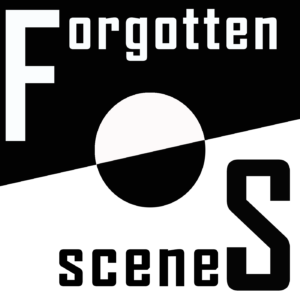
Category Archives: History
The Kraken Busters- now in (experimental) comic form!
So you’ve probably heard me talk about the book I wrote about the US Navy fighting sea monsters in the 1940s, and then the subsequent podcast adaptation that I did of it. Well, I have a terminal case of Cartoonist Brain, so with a story like that sloshing around in my head, it was inevitable that O’d start getting ideas about different ways that it could be presented visually. And this started to drive me nuts.
And then, inevitably: I sat down to give it a shot. So here is Episode 1 of a notional Kraken Busters comic, trying out some visual ideas and also leaning into some cartooning techniques I’ve never tried before. This might be a one-off, or it might be the start of a massive ongoing project to adapt the whole thing; if you dig it, please let me know, because that could help determine which way this goes (same thing, I guess, if you really think it sucks!).
| Next >

Announcing Forgotten Scenes
So I’ve started another fake history podcast! After two seasons of fake military history in The Kraken Busters, I thought it might make sense to switch back into my proper lane and do some fake cultural history. So: I’d like to introduce you to Forgotten Scenes, a show where I look at little cultural supernovas that might or might not have existed.
The first season is called “The Freaks in the Barn,” and it chronicles a little psychedelic glam rock scene that exploded (or didn’t) after David Bowie was (or wasn’t) briefly stranded in Sioux City, Iowa, in 1972 and infected a bunch of local weirdos with the idea of glam rock. Aside from Bowie, you get to meet a Texas-wannabe car dealership heir, a woman who might’ve accidentally summoned the devil to a rock show, and a hardline prairie-Maoist proto-punk band.
The show’s a ton of fun, and should be findable at all of the usual podcast outlets. I’ll also try to aggregate episodes here as they go live (which should happen once a week while the season’s running).
The Kraken Busters
THE KRAKEN BUSTERS is a new podcast project I have going, telling the story of the somehow-mostly-forgotten conflict between the United States and an ocean full of angry sea monsters just after World War 2.
If you like Mike Duncan and Dan Carlin but wish their work had more giant squids and octopi, well, this is the show for you.
New episodes come out weekly. You can find the show at all of the usual podcast outlets, or stream it directly from the site.
FRANKLIN, CHARLES SCHULZ’S ACCIDENTAL TOKEN
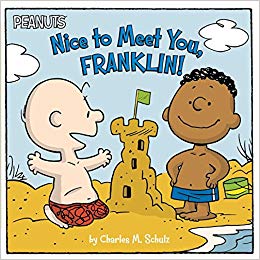
It always hurts to talk about when one of your heroes fails, but that’s what I’m out to do here. Charles Schulz is one of the great figures in comics; Charles Schulz sometimes fell on his ass. He did here. Acting with well-documented good intentions, he tried to do a good thing, and slid into what could most charitably be called mixed success. By introducing Franklin, a black character, into his immensely popular comic strip Peanuts, Charles Schulz wanted to harness his cultural power and use it to send a positive social message about racial harmony. He explicitly wanted to integrate his strip in a way that wasn’t demeaning or insulting. Thirty years later, though, Franklin was considered one of the prime exemplars of tokenism, a perception that has only grown as time has continued to pass.
Peanuts in 1968 was a cultural juggernaut, appearing in well over 2500 newspapers. In an era when newspaper comics carried a cultural weight nearly unimaginable today, Schulz was at the very top of the profession, giving him one of the most visible platforms in the country to trumpet any message he chose.
For the most part, Schulz avoided politics in the strip, instead examining emotional and existential humor.

Berlin: Living History

As my wife and I were flying into Berlin, I experienced a small wave of panic. What had I gotten us into? Was this going to be boring? What was there to do here, really? My initial pitch for Berlin as a vacation destination was that I wanted to go because of “all the history.” That sounded great and persuasive, in a vague way, sitting in Minneapolis. But now that we were about to arrive and spend a week in a foreign city where we didn’t speak the language, what did it actually mean? A week of looking at historic-site plaques? Was this going to be boring and dumb?
Happily, my little moment of freakout was entirely misplaced, and my initial instincts were right on point. Berlin isn’t a city with a lot of obvious, high-profile capital-letter Tourist Attractions; but it’s something much better: a fascinating, beautiful place where the weight of history is indeed so present and prevalent that if you’re interested in it at all, you can’t help but feel like you’re swimming in it.
I’ve been obsessed with World War II since I was 7, when I stumbled across a series of Time-Life books about the war, full of arresting, graphic photos, that my parents had left sitting around (my parents did a spectacularly bad job of shielding me from age-inappropriate material when I was a kid). My obsession with the cold war started about a year later, when my 3rd grade teacher rhapsodized proudly to my class about how our city of Blair, Nebraska, being just up the road from Strategic Air Command HQ in Omaha, would be one of the first Soviet targets when the missiles flew.
These obsessions were the initial impetus for wanting to see Berlin. My last-minute panic was based on a fear that neither the cold war or World War II lent themselves to spaces that made for fun vacation visits. My salvation was that this didn’t matter when the fabric of the entire city is visibly and irreparably altered by events. I can’t say that it’s fun to stand in the Tiergarten and read a plaque about how the trees surrounding you were all completely deforested by air bombardment and by Soviet troops advancing over the ground you’re standing on, or to stand in front of your hotel and look at the memorial cobbles commemorating Holocaust victims who once lived there; but it’s affecting and awe-inspiring in a way that transcends fun. It hits you on a different, deeper frequency. It drives home the way in which you are part of a larger continuum of human experience.
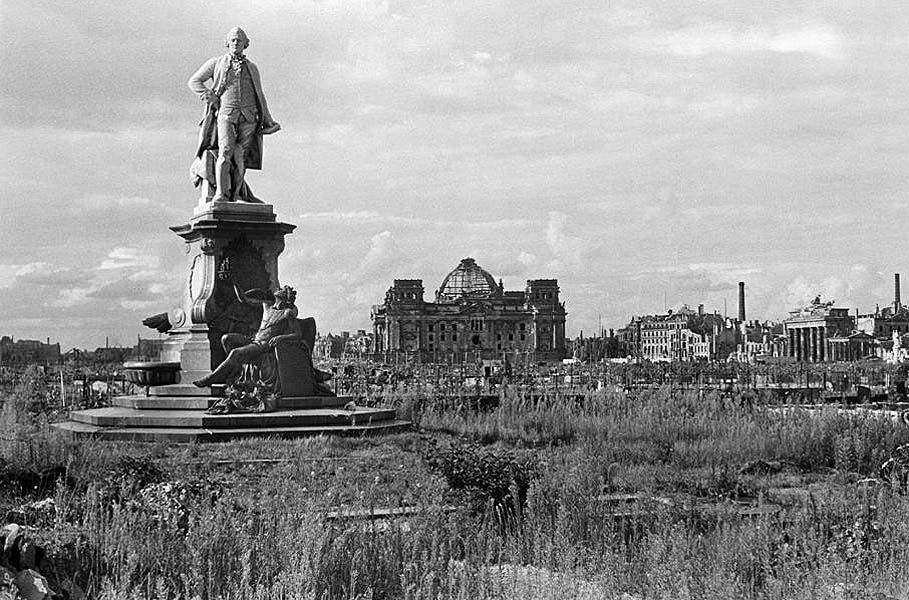
It’s one thing to walk into a museum and look at art and artifacts. It’s another thing entirely to see bullet holes in the interior wall of that museum and realize that what you’re looking at is evidence that there was a firefight in this building between people trying to take the building’s contents and people trying futilely to defend them. Again, that’s not fun, but it’s profound and affecting on an entirely different emotional spectrum.
(And about that fight: the scene I’m describing here is in the Neues Museum, which is largely full of Egyptian artifacts looted from Egypt by Prussian archaeologists in the 19th century; the top few floors, though, are European objects. Several gallery labels and signs on those floors pointedly mention that objects formerly on display here were looted by Soviet soldiers, taken to Moscow, and never returned. The irony of this kind of complaint in this kind of building is exactly what makes the historical experience of Berlin so mesmerizing.)
Consider this: in central Berlin, on land that was once part of the Berlin Wall and its “death strip,” is the Memorial to the Murdered Jews of Europe, an immersive, block-wide labyrinth of pillars that is one of the most viscerally affecting memorials I’ve ever experienced. On a block adjacent to this memorial is the nondescript parking lot that is the former site of the bunker where Hitler killed himself and was cremated. Running between these two blocks is a street named after Hannah Arendt. The historical resonances of Berlin come in a very strong, undiluted form.
History is a river. Things happen, and subsequent things downstream are driven by what happened previously. Hitler hijacked the German political system, started a war and conducted genocide, and Berlin was occupied and nearly leveled as a result; and then, downstream from that, the occupying forces eventually split the city in half, traumatizing the city with an unnatural internal boundary for half a century. That trauma, and the subsequent jubilation and rebirth, are as plain to see in Berlin as the immediate effects of the war. In place names (Rosa Luxemberg Platz, Marx-Engels Platz), architectural styles, and even traffic signage, the old separation between west and east is still plain to see if you bother to look for it. And that’s ignoring the hunks of the wall itself that have been left up as commemorations or memorials or just plain tourist attractions.
I can’t think of any American cities that have left me this strongly with the sense of standing amid the structure of history. The closest I’ve come is the southern end of Manhattan. New Orleans probably can provide the same effect if you walk around with your eyes open in the right way. I haven’t been to Boston, but I’m sure it has some amount of resonance. But overall, American cities operate under a couple of different conditions: no American city has undergone repeated traumas as massive as Berlin, and the American mode of operation is to march stridently away from the past, not to acknowledge it. You’ll find precious few memorial cobbles scattered around American cities to commemorate the victims of slavery or the Native American genocide. And as far as that goes, I’m painfully aware of my own white middle-class nature here; when I say that “no American city has undergone repeated traumas as massive as Berlin,” I recognize that, say, Dakota people currently living in Minneapolis no doubt have an extremely different viewpoint on that matter.
To my perception, at least, the everyday culture of 2019 Berlin had a laid-back, free-spirited vibe that I found immensely refreshing. In all kinds of little ways, from casualness with dogs to willingness to abruptly repurpose old buildings to surprisingly low levels of fussiness (and disclaimer paperwork). In the aggregate, this seems to me to add up to a much greater tolerance for uncertainty and risk in Berlin than one finds in litigious, fear-dominated America. Maybe that’s just the German national character now, or at least the Berlin civic character. But maybe it has something to do with living in a city that’s been through several different flavors of hell within living memory, much of it self-inflicted, and then undergone a rebirth. After all you’ve been through, all of which you still viscerally feel just walking down the street, why worry about whether people on a bike tour are wearing helmets? What’s the worst that could happen?
In 1933, a fire gutted the Reichstag building, giving Hitler the political opportunity to consolidate power and bring the Weimar Republic era to a formal close. In 1945, the shell of the Reichstag building served as one of the final redoubts for German soldiers defending the city, and the central objective for Soviet soldiers fighting through the Tiergarten and across the river Spree. After Germany reunified, the building was rehabilitated to serve as the seat of the new German parliament. To symbolize the new era of governmental transparency, the Reichstag’s original 19th-century dome was replaced with a large glass beehive lined with spiraling walkways, from which one can climb up and look out at the city, or down at the legislative chamber directly below. The vagaries of trip scheduling dictated that we could only get in to climb the beehive at 9:45 on the last night of our time in Berlin, so we visited it on a clear, slightly chilly spring night. It is by far the most beautiful and aesthetically powerful governmental building I’ve ever been in, so emotionally affective that even the presence of an enormous group of rowdy Italian teens wasn’t enough to stop it from being wonderful, standing there at a focal point where history happened and where the future is created, staring out at the rest of the city. It turns out that Berlin does indeed have some world-class tourist attractions.
APPROACH THE THRONE: SERENA WILLIAMS, SPORTS ILLUSTRATED, AND THIRD-WAVE FEMINISM
 I’d like to start out by laying out a few background statements to take for granted in the interest of time. First, that Serena Williams is a remarkable figure in terms of dominance, significance, and public profile in the sport of tennis. Second, that Williams’ outsized public profile has largely been mediated by photography. And that these photographs have existed within an environment of toxic discourse on Williams’ appearance, in a pattern mirroring that of such other prominent black women as Michelle Obama and Leslie Jones.
I’d like to start out by laying out a few background statements to take for granted in the interest of time. First, that Serena Williams is a remarkable figure in terms of dominance, significance, and public profile in the sport of tennis. Second, that Williams’ outsized public profile has largely been mediated by photography. And that these photographs have existed within an environment of toxic discourse on Williams’ appearance, in a pattern mirroring that of such other prominent black women as Michelle Obama and Leslie Jones.

Continue reading APPROACH THE THRONE: SERENA WILLIAMS, SPORTS ILLUSTRATED, AND THIRD-WAVE FEMINISM
THOMAS EAKINS, BRUSHING AGAINST THE LIMITS OF SCIENCE
Suppose you’re a painter, and you want capture a realistic scene of two men playing chess in a parlor. How would you do it? Most people, I think, would sit in the room and paint what they saw. Or, depending on their era, maybe they’d work from a photograph. A very meticulous artist might pencil out couple of single-point perspective lines to guide the recession of the room’s furniture. Vanishingly few artists would use a separate sheet of paper to create a 3-dimensional gridded space where everything in the room was geometrically plotted out with each object considered as its own individual study. But this is exactly what Thomas Eakins did.
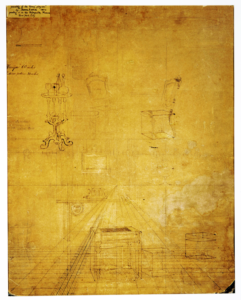
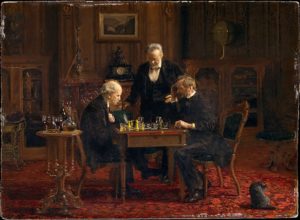
There’s a decent chance your reaction is: Thomas Who? Eakins is an odd case, a man considered one of the leading American painters of the back half of the 19th century who has slowly slid into something that isn’t quite obscurity but is pretty far from household-name status. You’ve probably heard of the people considered his peers at the time: Winslow Homer, John Singer Sargent, James McNeil Whistler, (kinda) Mary Cassatt. A combination of scandals (Eakins was heavily involved in art education, and was involved in scandals revolving around nude models and students, and it’s a dense thicket that’s almost impossible to judge from 130 years out without getting lost in the gap between then-contemporary and current social mores; last time I looked, his wikipedia page was dominated by speculation about his sexual preference), changing tastes, and the random drift of history have shunted him off to the side. But in his day, Eakins was a big deal, renowned as a new kind of big-brained artist.
Eakins was a creature of his time. He worked during a period of unprecedented exuberance about the progress of science. He brought that spirit into his artistic practice, pursuing representational realism through a combination of techniques derived from science and mathematics. His approach was powerful but flawed, with inconsistencies that led to visual paradoxes; similar paradoxes lurked around the edges of the very science world that inspired him.
Eakins’ belief that perfect representation of reality could be attained in painting through advanced science-based technique was a manifestation of a mode of thought pervasive in late 19th-century American and European intellectual circles, an idea that science and knowledge had reached a summit. His social position in the academic elite of Philadelphia put him in contact with scientists, artists, and thinkers whose output presents a similarly teleological outlook. He basically soaked up their hubris. And this isn’t something I can claim to prove, but I’d guess that the passing of that particular scientific worldview has something to do with the slow drift of Eakins into semi-obscurity.
Continue reading THOMAS EAKINS, BRUSHING AGAINST THE LIMITS OF SCIENCE
A BRIEF VISUAL WALK THROUGH THE HISTORY OF BLACK MILITANT IMAGERY
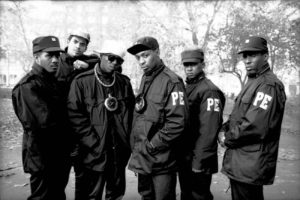
I’ve been a Public Enemy fan for a long, long time. They were one of my primary gateways into hiphop. Loved the production, the politics, the interplay between Chuck’s and Flav’s voices, the whole package. And the aesthetic. Let’s not kid ourselves, Public Enemy has a very distinct aesthetic.
It’s a very militaristic aesthetic. Uniforms, military signifiers, a lot of berets. The guys in the berets, of course, are the S1Ws (for “Security of the First World” in PE parlance). Theoretically, they’re PE’s security force. Functionally, they dance at shows and look cool at press events.
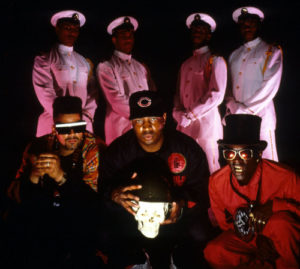
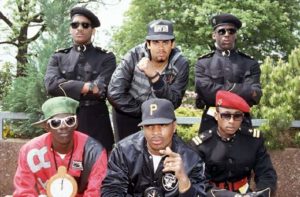
Anyway, Public Enemy is a smart band and Chuck D is a smart guy in particular. This isn’t random. This resonant look came from somewhere. It’s naggingly familiar.

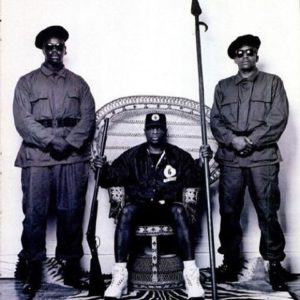
It’s naggingly familiar because it’s pretty much a direct visual quote of the distinct aesthetic of the Black Panthers. It’s clearly not an accident.
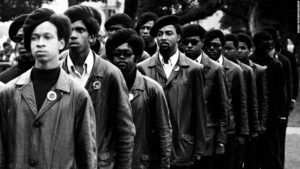
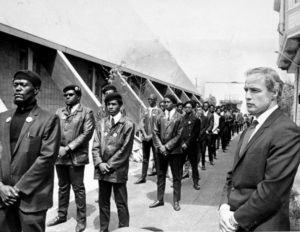
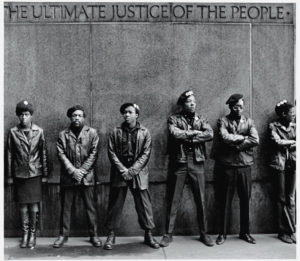
The Panthers, for what it’s worth, were very savvy about the use of imagery. They were great at mass communication; I’ve seen some fascinating presentations about their use of visual art in their newspaper.
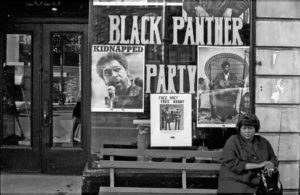
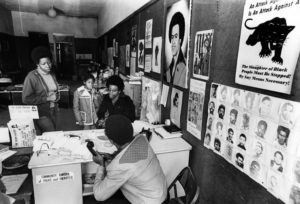
So, OK. A militant rap group borrowed some visual tropes from a militant political group. So what?
Well, the interesting thing is that the Panthers pretty clearly borrowed a lot of elements of their look – the military signifiers, the regimentation – from the Nation of Islam. If you’ve read this far, you probably already know who the Nation of Islam are; if you don’t, they’re a major combination Black nationalist/religious group. They have supporters and detractors, but you can’t really minimize their importance in the history of 20th century America.
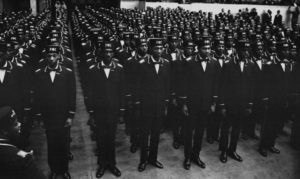
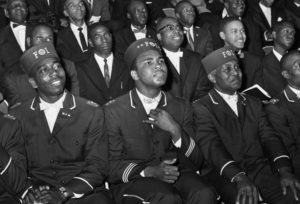
And here’s where it gets really interesting… the Nation of Islam, in their turn, clearly borrowed a lot of their imagery from Marcus Garvey, the pioneering pan-Africanist / Black nationalist who was active in the early part of the 20th century.
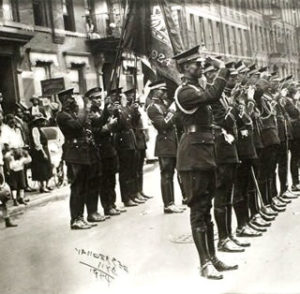
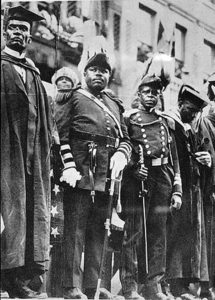
These pictures of Garvey are from 1924. The one on the right was taken by James Vanderzee, a prominent Harlem photographer.
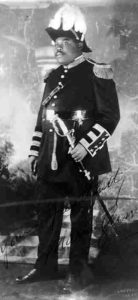
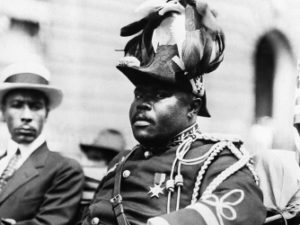
So, OK, we can trace this thread of visual signifiers for Black militancy back to the 1920s. What of it?
Well, here are some paintings of heroes of the Haitian revolution, the only successful rebellion by African slaves. Pretty obvious thing to hearten back to if you’re Marcus Garvey.

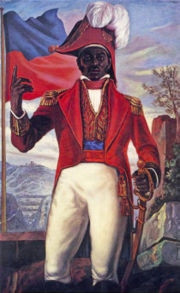

Pictured above, we have Toussaint Louverture, Jean-Jacques Dessalines, and Henri Cristophe. Those uniforms look a lot like the uniform Marcus Garvey was wearing, which of course inspired everything after.
(By the way, do Michael Jackson’s bedazzled military uniforms make more sense now? They should)
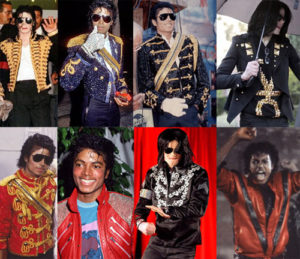
So… Public Enemy is old news. Barely a band now. What does this have to do with today?


Well, Beyonce’s 2016 Super Bowl Halftime show wasn’t that long ago.

And that freaked some people right the fuck out.
This imagery is obviously still present, and still powerful.
–Fin–
Oh, but:
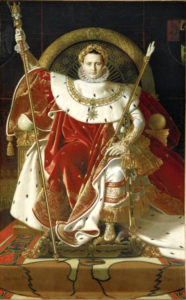

THERE AND BACK AGAIN, FOR ONCE
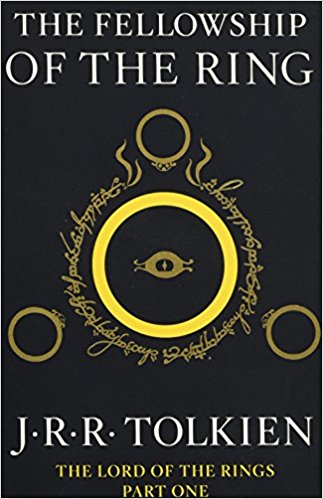 One of the recurring themes of my adult life has been my getting the itch to go back and take a look at some book or movie or album that I loved when I was younger but haven’t re-engaged with for a while. The vast majority of the time, I walk away from the revisit shaking my head and telling myself that hey, it’s no crime to have liked something bad or silly when you were younger.
One of the recurring themes of my adult life has been my getting the itch to go back and take a look at some book or movie or album that I loved when I was younger but haven’t re-engaged with for a while. The vast majority of the time, I walk away from the revisit shaking my head and telling myself that hey, it’s no crime to have liked something bad or silly when you were younger.
So, recently I got the revisit urge for Lord of the Rings. I was pretty sure I knew how this was going to play out; I hadn’t read Tolkien since 2002, and I did vaguely remember not digging it at the last go-round. Which had been a bummer- these were foundational books to me in the 80s and 90s, but my turn-of-the-century reaction had been that the books were humorless, and trite, and just generally kind of bad.
A few things have happened to me since 2002, though. Big-picture, I’ve lived an adult life, with attendant ups and downs. More directly relevant, I’ve gained a historical consciousness, reading a ton of history (both cultural and political) and particularly boning up on World Wars 1 and 2.
And that’s the key. While I think there’s a lot of valid criticism that can be aimed at Lord of the Rings, I absolutely loved it on this reread, and a great deal of that love is based on my fascination with the way that Tolkien’s experience in World War 1 is smeared onto every page of the book (even beyond the physical descriptions of places around Mordor sounding almost word-for-word like descriptions of Western Front battlefields). Tolkien was at the Somme, arguably the most disastrous and harrowing British military experience of the 20th century. As he points out in the preface to The Fellowship of the Ring, by 1919, most of his close friends were dead. British tactics at the Somme were, essentially, to hop up out of somewhat-safe trenches in waves, charging into a maze of barbed wire covered by German machine guns. You’d watch the wave ahead of yours go over the top and get cut to pieces. And then the officers would blow their whistles and your wave would go. Tolkien survived the war because a serious illness brought on by lice bites took him off of the firing line. But he saw a lot of people he knew die. And, as a junior officer in WW1 infantry, he was trained to order men to immediate, useless deaths and display leadership by joining them.
DAVID BOWIE IS__ A BIT OF AN INTERPRETIVE MUDDLE, BUT PRETTY WORTHWHILE IN THE END IF YOU’RE INTO THAT SORT OF THING
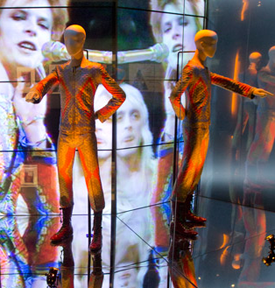 This was originally written as a paper for an art history class in curation.
This was originally written as a paper for an art history class in curation.
Last year, my birthday fell shortly before David Bowie Is, the “first retrospective of the extraordinary career of David Bowie,” closed its run at the Museum of Contemporary Art in Chicago. My wife surprised me with tickets to the long-sold-out show. We packed for a crash road trip, hopped into the car, and drove from Minneapolis to Chicago, listening our way with mounting excitement through the entire Bowie oeuvre during the 10-hour trip.
Viewing the exhibit was an overwhelming rush; the line to enter the museum had stretched around the block. The show was designed to hit attendees through multiple senses – as one walked through the space looking at objects, a location-sensitive headset would blast music or interview clips related to the object under view. The crowd itself – packed into the galleries as tightly as the fire marshals would allow – provided a constant buzz of energy as several rooms full of Bowie superfans communed with artifacts connected with the great man.
We left the exhibit exhausted and happily dazed. But on the drive back to Minneapolis, questions started to bubble up as we talked it over. What had we learned in that exhibit? It didn’t really seem like we’d gotten much in the way of new information. The experience had been intense and fun, but had there been an intellectual point? Had the whole thing really been an enjoyable but ultimately empty wallow in pop idolatry? As months passed and the undigested bolus of David Bowie Is lingered in my head, a slow, slinking surety settled in that it had all been a lot of sound and fury, signifying nothing.
Kirk and Picard were both on the hook for a bunch of these…
 UNITED FEDERATION OF PLANETS
UNITED FEDERATION OF PLANETS
FORM TST-6- TEMPORAL DISPLACEMENT IMPACT ASSESSMENT (PAST)
for temporal displacements to the future, file form TST-7a
Filing officer information
Name:
Rank:
Starfleet ID:
Duty vessel:
Stardate of initial temporal displacement:
Stardate temporally displaced to:
Stardate returned to, if applicable:
Displacement involved (circle appropriate): ship / crew / both
Displacement was (circle appropriate): accidental / intentional
Number of Starfleet personnel displaced:
Number deceased while displaced:
Number of non-Starfleet individuals displaced:
Number deceased while displaced:
Answer these questions as completely as possible:
1. List all past-resident individuals encountered during displacement (using red pen, circle names of all past-resident individuals killed during displacement):
2. Using a 1-6 scale (1 unimportant, 6 critical), rank all individuals listed in question 1 in terms of their importance to known history:
3. Describe, in as much detail as possible, all interactions with past-resident individuals during displacement (attach additional sheets if needed):
4. Was any knowledge of future events or technology imparted to past-resident individuals during displacement?
If yes, list future events or technology discussed:
5. Were any present-resident individuals left behind in the past?
If yes, list their names and (if relevant) Starfleet IDs:
6. Were any past-resident individuals brought forward to the present?
If yes, provide as much identification data as possible:
7. Were any physical technological artifacts from the present left behind in the past?
If yes, list:
8. In your professional opinion, is it likely that a branching timeline was created by this displacement?
If yes, is it likely that this timeline is dystopian?
9. Rank, on a scale of 0-6 (0 is minimal, 6 is severe), your impact on the course of known history during the displacement:
THANK YOU FOR YOUR COMPLIANCE WITH STARFLEET TEMPORAL DISPLACEMENT REGULATIONS. YOU WILL BE CONTACTED FOR FURTHER DEBRIEFING WITHIN 10 BUSINESS DAYS OF SUBMISSION OF THIS FORM.
History Is Hilarious – The Ol’ Fez Switcheroo
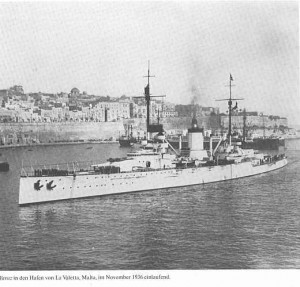 I’m about halfway through Barbara Tuchman’s exceedingly excellent The Guns of August; World War I had always been a gap in my 20th century history, and I’ve always heard good things about the book. I’m really happy to say that it justifies the hype. It’s fascinating and – weirdly – hilarious. The more I read, the stronger my impression that Europe in 1914 was under the collective rule of one of the biggest gang of boobs in history, and that if World War I didn’t have such a horrible body count associated with it, it would rank as one of the great comedic acts of mankind.
I’m about halfway through Barbara Tuchman’s exceedingly excellent The Guns of August; World War I had always been a gap in my 20th century history, and I’ve always heard good things about the book. I’m really happy to say that it justifies the hype. It’s fascinating and – weirdly – hilarious. The more I read, the stronger my impression that Europe in 1914 was under the collective rule of one of the biggest gang of boobs in history, and that if World War I didn’t have such a horrible body count associated with it, it would rank as one of the great comedic acts of mankind.
Consider the case of the German battleship Goeben and her companion, the cruiser Breslau.
At the outbreak of hostilities in 1914, Goeben and Breslau were stationed in the Mediterranean. Shit hits the fan. War breaks out. Because of a network of pacts, you abruptly have a situation where noted world powerhouse Serbia is allied with Russia who’s allied with France who’s allied with England, opposing Austria-Hungary and their allies the Germans. The Ottoman Empire is neutral as things start out. They don’t like the Russians much, but they have a longstanding relationship with England, and there are a lot of German sympathizers in the Turkish military. They could go either way. And they’re strategically important, since all of the good warm-water ports supplying Russia depend on shipping traffic through the Dardanelles.
So. The Ottomans, a crucial swing state that could go either way. What do the British do to win them over? They seize a couple of completed battleships that they’d been building for the Ottomans. Ace diplomacy there.
Continue reading History Is Hilarious – The Ol’ Fez Switcheroo
